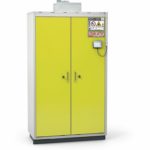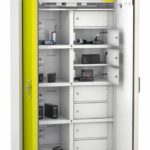Although lithium-ion batteries are relatively safe in regular operation, they are not designed for temperatures above 60 °C, among other things. As the temperature rises, lithium-ion batteries react with pressure build-up in the cell, intensive emission of flammable gases, cell fire, and even explosive burning of the battery (thermal runaway). The dangers result, among other things, from deficiencies in production or improper handling of the storage medium. A further risk arises if, for example, the respective ingredients are released due to thermal stress. According to the technical data sheets of the manufacturers, corrosive, toxic, carcinogenic, but also flammable hazardous substances can escape. Accordingly, preventive measures for fire protection and early detection of damage are important building blocks to ensure safe workplaces.
Safety storage cabinets
In the classical solution, Type 90 safety storage cabinets according to DIN EN 14470-1, the stored media are shielded from external thermal influences, e.g. fire generation outside the safety cabinet, and are regarded as a fire-resistant separated area (fire compartment). They offer 90 minutes of fire resistance – sufficient time for evacuation and a safe buffer for fire fighters to intervene. This prevents uncontrollable fires and explosions and, as a result, increased personal injury and material damage if a fire occurs – exclusively – outside the cabinet.
Düperthal safety cabinets of the Battery line Type 90, on the other hand, are specially designed to meet the high requirements for the safe storage and charging of lithium-ion batteries. In the event of a malfunction, lithium-ion batteries can ignite themselves and the thermal load or fire then occurs inside the cabinet. In this scenario, the cabinet doors will close automatically and a special mechanism will lock them. This prevents employees from igniting a possible flue gas explosion (backdraft), by simply opening the doors. Only authorised persons and fire brigade experts will be able to unlock the doors in this case. With the classification Type 90 and the explosion-like burning of the batteries in the cabinet interior, tested by the independent Fraunhofer Institute, the Battery line offers double fire protection – sufficient time for evacuation and a buffer for extinguishing the fire.
Early detection
The success of extinguishing a fire is essentially dependent on the fire brigade being on-site as early as possible in the fire phase. For the storage and use of lithium-ion batteries, early detection and automatic transmission of thermal events, e.g. fires, is therefore almost indispensable. With the intelligent Smart Control assistance system with touch display, temperature sensors can be used as an early warning system to detect thermal events inside the cabinet, e.g. threshold value adjustment to detect deviations from normal cases. For preventive risk management, in addition to monitoring temperatures using sensors for door status and ventilation, fault messages can also be sent by SMS, e.g. to the fire brigade and to those responsible. Individual connection to fire alarm systems is also possible. The Battery station models are additionally prepared ready to plug in with Schuko sockets and a fused power supply for chargers. The Battery line’s prepared ventilation system can also safely dissipate the heat energy generated by the charging process.
State of the art safety at work
Within the framework of a risk assessment, operators are obliged to assess the dangers which may emanate from technical equipment and devices and to implement the resulting protective measures in accordance with the state of the art. The Battery line and the additional systems for early fire detection with automatic alarm forwarding capability ensure sustainable process safety. The resulting danger containment in case of self-ignition of the batteries can be considered as state of the art in the hazard analysis. The use of the Battery line also helps to meet legal requirements, in particular the guidelines for storage in accordance with the GDV data sheet on loss prevention for lithium-ion batteries of the VdS and FM Global.
Düperthal Sicherheitstechnik GmbH & Co. KG, Karlstein, Germany










